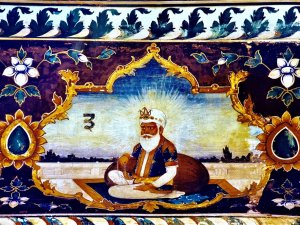
In Part I; we explored how the legacy of humility was passed on from the first Guru Nanak Dev Ji to the fifth Guru Arjan Dev Ji. Now in Part II; we will explore the source of humility in a person along with the incidents of extreme humility displayed by remaining Gurus; from the sixth Guru Har Gobind Ji to the tenth Guru Gobind Singh Ji. Before exploring this part let us ask Guru Arjan Dev Ji again about the effectiveness of the weapon of humility. Guru Ji sums it up in one line:
"iesu AwgY ko n itkY vykwrI ]"
"Eis aagai ko n ttikai vaekaaree." -- (SGGS, Pg. No. 628)
Meaning: No evil-doer can withstand these weapons.
When the sixth Guru Har Gobind, sat on the throne of Guru Nanak he started a new tradition by wearing two swords symbolizing devotion and strength. Thus he gave a new image and a new direction when a life of suffering, surrender, and self-denial was considered the true sign of a religious person. Guru Har Gobind Ji unsheathed his shining sword, and declared war against the unrighteous empire of India. By wearing two swords Guru declared that he was a friend of the oppressed and a foe of the oppressors. Although the Sikhs used to address him as True king, humility was his way of life. Let us experience that from an incident related to Manohar Das, a great saint himself as well as the great-grandson of Guru Amar das. Guru Har Gobind Ji could not attend his funeral. He went into a deep prayer for him. Later, Guru Ji sent out an invitation to Anand Rai son of Manohar Das to visit him.
Anand Rai travelled in a palanquin to visit Guru Ji. When Guru Ji heard about his arrival Guru Ji came out and in a gesture of welcoming put his shoulder under the palanquin and carried Anand Rai. When Anand Rai saw Guru Ji he alighted from the palanquin and bowed down to Guru Ji saying; "Why do you treat me with so great a kindness? I am just the dust of your holy feet. What if bamboo grows tall? It cannot be fragrant like a sandal-tree." Guru Ji smiled and replied; "Without the service of the saints man is a barren rock." So, we can see although Guru Ji established a new strategy after the torturous execution of Guru Arjan Dev Ji he still lived with extreme humility.
The seventh Guru Har Rai was a grandson of Guru Har Gobind Ji. As a child he always wore a heavy dress with a lot of pleats. One day when he was passing through Guru Ji's garden, the pleats of his dress struck a flower blossom which broke off and fell down on the ground. Har Rai Ji accidently stepped on the plucked flower while walking through the garden. Guru Ji saw this and said to Har Rai Ji; "My son! Always watch out when you move around. Otherwise you may disturb the slumber of union of some blessed ones, tear them away from God; as you have torn this flower from its branch." Har Rai Ji was deeply moved by these words and he took the advice to his heart for the rest of his life. After this incident whenever he walked, he carefully gathered the pleats of dress, so as not to repeat the incident again. Such was the humility of character that Guru Har Rai retained for the rest of his life. In fact the following Salok by Farid Ji from Guru Granth Sahib Ji became his dictum for life:
"sBnw mn mwixk Twhxu mUil mcWgvw ] jy qau iprIAw dI isk ihAwau n Twhy khI dw ]"
"Sabhanaa mun maanik thaahan mool machaangavaa. Jae tao pireeaa dee sik hiaao n thaahae kehee dhaa." -- (SGGS, Pg. No.1384)
Meaning: The minds of all are like precious jewels; to harm them is not good at all. If you desire your Beloved, then do not break anyone's heart.
Thus, living a life of humility Guru Ji inspired others to lead a life of humility.
Now, let us look at the incident from life of the eighth Guru, Har Krishan Ji who became Guru at the tender age of five. Emperor Aurangzeb the ruler of the times asked his minister Raja Jai Singh to invite Guru Ji to Delhi, so that he could hear him in person before deciding on the case brought by Ram Rai about the rightful heir to Guru Har Rai. Guru Ji responded that he would be willing to come to Delhi at the invitation of the Raja and the Sangat of Delhi but not to visit the Emperor. Raja acceded to this condition and promised that visiting the Emperor would be Guru Ji's decision alone.
Guru Ji made plans and set out for Delhi from Kiratpur. On their way the party halted at village Panjokhara in the Ambala district. At the village many excited visitors came to visit Guru Ji and have his Darshan. Seeing the stream of visitors heading in that direction a Brahmin named Lal Chand asked them where were they heading? The villagers replied they were heading to visit the camp of Guru Har Krishan Ji. Lal Chand said; "Anybody can call himself Krishan; but does he have the qualities of Krishan? In addition to his name there is a prefix Har; is he greater than Krishan? How old is he?" On learning Guru Ji’s age he remarked; "Krishan gave us Gita; but can he even interpret a single Saloka of Gita?" The villagers informed Guru Ji about the taunts of Lal Chand. Guru Ji asked villagers to bring Lal Chand to him. Guru Ji told him; "There was no scarcity of anything in the house of Nanak, including that of knowledge. If I explained the Saloka you may still harbour doubts in your mind. Why don't you pick any person of your choice and let us hear the explanation from him. You will yourself witness the blessings of Nanak." Lal Chand picked Chajju a dumb and illiterate water carrier, who was standing nearby. Guru Ji then beckoned to Chajju to come closer and touched Chajju's head with a stick he was holding in his hand. Upon the touch of the stick, a magical transformation took place in him. Lal Chand quoted the Salokas and Chajju elucidated them with supporting quotes from Upanishads and Vedas. Lal Chand was amazed; he realized his folly and apologized to Guru Ji for his behaviour. He further added that; "I see that you are Holy god Krishan himself. Guru Ji explained to him the three golden principles of life as laid out by founder Guru Nanak Dev Ji: meditation, honest work and sharing with all. Guru Ji also shared quote from Guru Nanak Dev Ji about humility (see Part I of this article.) Lal Chand experienced the power of humility defeating his pride and that experience transformed him. He himself became a Sikh and Guru Ji assigned him to be the teacher of Sikhism in the area.
Guru Har Krishan Ji shed his mortal coil at the age of twelve and he advised the Sikhs that the next Guru was in Bakale. Dhir Mall elder son of Baba Gurditta declared himself as the heir. Although Guru Teg Bahadur was formally declared as the ninth Guru by Makhan Shah, but Dhir Mall still had his aspirations of becoming the Guru. He hatched a conspiracy with Masand Sheehan to attack Guru Tag Bahadur Ji. When Sheehan got wind that Makhan Shah had departed with his soldiers they decided to put their plan into action. Dhir Mall and Sheehan along with their twenty-five gunmen reached Bakala. When Guru Ji saw Dhir Mall, Guru Ji asked him to desist from his nefarious designs. But Sheehan got closer and fired a shot at Guru Ji. The shot bruised the shoulder of Guru Ji yet he remained calm and composed. In the meantime the attackers plundered Guru Ji's house and retreated after helping themselves to the valuables.
As soon as Makhan Shah found out about the incident, he marched to Dhir Mall's camp with his soldiers. Dhir Mall and his associates tried to escape but were nabbed and received a sound thrashing. They were all handcuffed and presented before Guru Ji along with the loot. Guru Ji not only pardoned Dhir Mall, Sheehan and their accomplices but he also asked that all the property to be returned to them. Makhan Shah decided to keep the Adi Granth as it was the property of all Sikhs. But Guru Ji scolded Makhan Shah and reminded him that Guru Nanak has given the wealth of Naam and there was no need for anything else. Truly, a magnanimous heart filled with humility is only capable of such an ungrudging gesture.
 Finally let us look at the life of our tenth Guru, Gobind Singh Ji. After leaving Anandpur during the siege, Guru Ji finally came to Damdama Sahib and dictated Guru Granth Sahib to Bhai Mani Singh who acted as the scribe. After completing this momentous task Guru Ji proceeded to south to see Aurangzeb. While passing through Alwar area of Rajasthan, Guru ji reached Narayanpur, generally known as Dadudwara, as it was a seat of the renowned saint Dadu. When Mahant Jait Ram, the head of the place at the time, heard about a king with his soldiers camping outside, he came out on a fact finding mission. It was evening time and Guru Ji was getting ready for the evening Darbar when he arrived. He met Guru Ji and invited Guru Ji to visit the mausoleum of Dadu Ji. Guru Ji was impressed by the by cordial sincerity and reverence of the Mahant and accepted the invitation. Guru Ji took the tour and heard from the Mahant about the life of Dadu Ji and also his connections with the earlier Sikh Gurus. When visiting the shrine of Dadu Ji, Guru Ji lowered his arrow in salutation to Dadu Ji. After completing the visit, Guru Ji returned back to his camp site. The Sikhs who had accompanied Guru Ji inquired about the gesture of salute with the arrow. They quoted his own words to him:
Finally let us look at the life of our tenth Guru, Gobind Singh Ji. After leaving Anandpur during the siege, Guru Ji finally came to Damdama Sahib and dictated Guru Granth Sahib to Bhai Mani Singh who acted as the scribe. After completing this momentous task Guru Ji proceeded to south to see Aurangzeb. While passing through Alwar area of Rajasthan, Guru ji reached Narayanpur, generally known as Dadudwara, as it was a seat of the renowned saint Dadu. When Mahant Jait Ram, the head of the place at the time, heard about a king with his soldiers camping outside, he came out on a fact finding mission. It was evening time and Guru Ji was getting ready for the evening Darbar when he arrived. He met Guru Ji and invited Guru Ji to visit the mausoleum of Dadu Ji. Guru Ji was impressed by the by cordial sincerity and reverence of the Mahant and accepted the invitation. Guru Ji took the tour and heard from the Mahant about the life of Dadu Ji and also his connections with the earlier Sikh Gurus. When visiting the shrine of Dadu Ji, Guru Ji lowered his arrow in salutation to Dadu Ji. After completing the visit, Guru Ji returned back to his camp site. The Sikhs who had accompanied Guru Ji inquired about the gesture of salute with the arrow. They quoted his own words to him:
"pUrn pRym pRqIq sjY bRq gor mVHI mt BUl n mwnY ]"
"Pooran prem pratteeth sajai brath gor marrhee matt bhool n maanai." -- (Dasam Granth, Page 1)
Meaning: He decorates himself with perfect love and faith, and believes not in fasts, tombs, crematoriums and hermit cells, even by mistake.
Guru Ji was very impressed that these Sikhs though young, and new to the faith, still possessed a thorough understanding of his teachings. They even declared that Guru Ji should be liable for a penalty, which after the formal deliberations was set at Rupees one hundred and twenty five.
Guru Ji was very pleased at the alertness displayed by the Sikhs. He admitted that technically he was in non-compliance and therefore liable for fine. He cheerfully accepted and paid the levied fine. This amount was used to procure a tent; it was used as Langar tent for dining purposes. Although Guru Ji lowered his arrow in a salute to test the Sikhs, when confronted with the penalty he showed the utmost humility in accepting the consequences. Thus we have seen that all the ten Gurus embodied the virtue of humility and displayed it in their lives through their deeds, their words and their very presence.
At last, having contemplated these examples of humility, we come to the question, "So what is the origin of humility? How can it be acquired?" Ultimately, humility comes by grace… but not directly. The grace lies within the experience of the Infinite. When the Dasam Duar (10th gate) opens and the vastness of Waheguru is experienced, beyond the mind and beyond the power of words to express, the experience of one’s own smallness in relation to the vastness of the entire creation creates humility within the human. From that moment forwards, remembering and experiencing that vastness in the state consciousness of Naam, one is always humble before God. The state of consciousness we call ‘Naam’ means to see God in all things. When we live in Naam we are humble before all because we see God in all
No wonder that the following prayer for humility has been incorporated within our daily prayer so that it acts as a catalyst and a reminder for us:
"isKW dw mn nIvwN, mq ayucI, mq pq dw rwKw Awip vwihgurU["
"Sikhaa daa mun neevaa, mut uchee, mut pat daa raakhaa aap Waheguru."
Meaning: May the minds of all Sikhs remain humble and their wisdom exalted; O God! You are the protector of wisdom.
As Sikhs we pray for humility and high wisdom to better serve humanity. Let us make this prayer our personal prayer. So with that quality of humility as our inner strength we can soar upwards on our spiritual journey. Let the humility shown in the lives of our Gurus inspire us to not only to become humble ourselves, but also to fill us with the love and awe of Ek Ong Kar in all people, places and things.
References:
1. Sikh Missionary Center. Detroit, MI. Sikh Religion
2. Jagdev, Santokh Singh. Bed Time Stories - 4.
3. Singh, Kartar & Dhillon Gurdial singh. Stories from Sikh History, Book III.
4. Singh, Bhai Vir. Kalgidhar Chamatkar - Volume II (in Punjabi)
5. Singh, Puran. The Ten Masters.
6. Singh, Ranbir. Glimpses of the Divine Masters.
7. Singh, Hakam & Chadda, J. S. Guru Teg Bahadur
---------------------------------
Related Article:
http://www.sikhnet.com/news/gurus-weapon-humility-part-i





